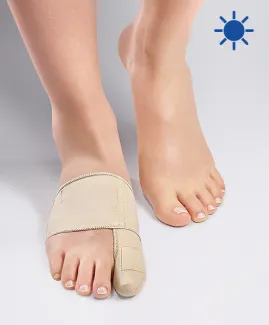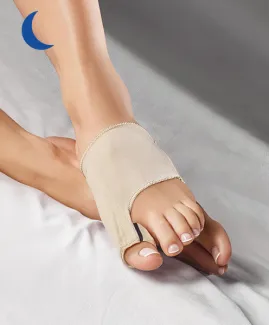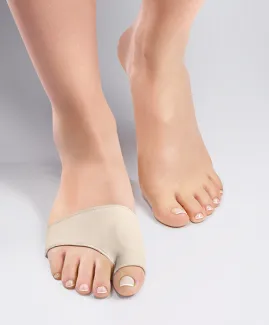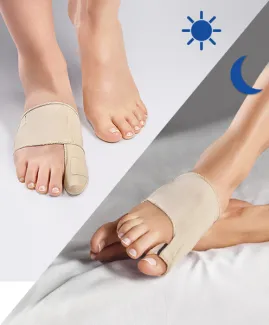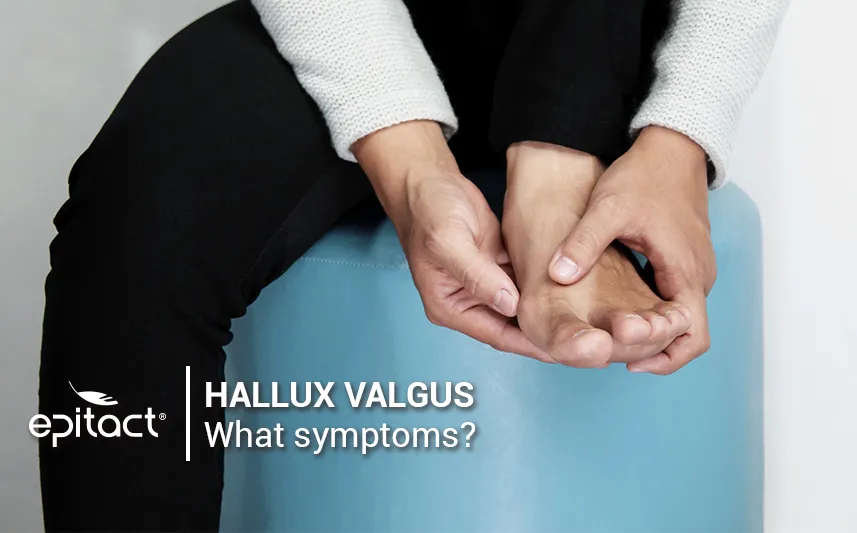
A bump or a redness has appeared on the inner side of your foot... Your big toe (hallux) wants to overlap its neighbour toe. You’re wondering if they are symptoms of bunions? EPITACT® helps you recognise the bunion pain and visual symptoms: what does a bunion look like? What does a bunion feel like?
What does a bunion look like?
The bony bump on the inner side of the foot is the major bunion symptom. Indeed, a bunion, or hallux valgus, is a deformity affecting the basal joint of the big toe. It is a double deviation that progressively deforms the forefoot(1): the big toe is in valgus (it drifts outwards), the first metatarsal is in varus (it drifts inwards). By the way, the bunion is not an excrescence that has suddenly grown but it corresponds to the head of the first metatarsal bone which juts out on the side of the foot.
In addition, this joint disorder contributes to the widening of the forefoot and can cause problems when wearing shoes or even walking. By progressing, the deformity causes balance disorders and the foot is so deformed and painful that it no longer fits in classical shoes and keeping on putting them just accelerates the process. Remember that hallux valgus is a deformity that cannot disappear over time.
That is how additional deformities (e.g.: hammer toes) related to the former ones worsen even more the situation. The lesser toes have less room because of the bulky bunion and may arch or be overlapping. Because the toes rub against each other or against the shoe, foot corns can develop.
Redness and inflammation are additional bunion symptom
The first bunion symptoms often go unnoticed. Redness can appear on the inner side of the foot where the big toe begins. This redness frequently leads to corns, then becomes inflamed and eventually causes bursitis. Pain is one of the first warning signs noticed by patients with this foot deformity.
Fortunately, even at this early stage, it is not too late to stop the process but you can wear a bunion protector* to relieve pain. It is particularly recommended in the case of frequent bunion pain or when the deviation progresses and becomes painful.
What does bunion pain feel like?
Bunions can be painless, but most of the time, they cause painful symptoms. As the deformity progresses, the bump rubs and presses the shoe. In the beginning, this contact is uncomfortable but it progressively becomes a throbbing joint pain.
This is symptomatic of the first internal joint problems that are linked with a bunion or hallux valgus. The bunion pain is especially due to the compression of the medial plantar nerve but also to friction between the soft parts of the foot and the shoe. These bunion symptoms manifest when wearing shoes, in particular with dress shoes (for example high heels for women). Therefore, it is recommended to wear shoes adapted to the bunion, i.e wide and flexible.
At this stage of the condition, it is essential to remove the cause responsible for the deformity. For this purpose, wearing the flexible bunion corrector* for day use is recommended to reduce friction and to distribute pressure better. What’s more, this bunion support aims to reduce the deviation of the toe during the day. At night or during resting periods, the EPITACT® rigid bunion corrector* is more adapted to stop the progression of the condition by realigning the toe. Your general practitioner may also prescribe you medication to relieve bunion pain.
Metatarsalgia and calluses are associated bunion symptoms
The toes and the first metatarsal are deformed and deviated so they don’t properly carry out their support function. A lateral weight transfer becomes inevitable and gradually leads to metatarsalgia in the middle metatarsal bones (pain in the forefoot). The repeated pressure often results in the formation of plantar calluses and corns which can be painful and disabling.
Bunions can cause joint stiffness
Hallux valgus causes unusual stress of the joint that progressively entails big toe joint stiffness. In the most severe cases, this process, which includes signs of osteoarthritis, accelerates until the luxation of the toe at the first head of the metatarsal bone.
When the joint isn’t moving anymore, wearing a brace is contraindicated. A medical consultation with a specialist or even surgery are often the last effective options to treat severe cases of bunion.
These are the most common bunion symptoms but others exist. All these warning signs should be considered to encourage people consulting a health professional as soon as possible. Foot care and regular monitoring associated with braces will be precious tools to reduce the progression of the condition and soothe the bunion pain.
*These solutions are class I medical devices that bear the CE marking under this regulation. Carefully read the instructions before use. Manufacturer: Millet Innovation. 04/2022
For more details about this general and simplified approach, here is another source:
(1)Vanore JV, Christensen JC, Kravitz SR, Schuberth JM, Thomas JL, Weil LS, et al. Diagnosis and treatment of First Metatarsophalangeal Joint Disorders. Section 1: Hallux valgus . The Journal of Foot and Ankle Surgery. Mai 2003; 42(3):112‑23.
 Pharmacie
Pharmacie